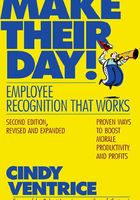
preface
I am excited to be bringing you this completely updated second edition of Make Their Day! Because companies are continually changing and evolving, I have updated the stories of the companies featured in the original edition. In some cases, I have retained examples of programs that companies are no longer using because the examples make an important point. With others there have been new developments that I believe will interest you. You will find that there are new examples from organizations such as Best Buy, Cisco, and Google demonstrating important recognition concepts. There are also new stories, insights, tips, and tools throughout that will help you provide the best possible recognition to your team!
I have added two chapters to this edition. The first addresses organizational culture. This chapter will help you, the manager, determine the effect that age, nationality, proximity to you, and even job description have on recognition preferences. The second new chapter addresses fairness. In my work, I have found that fairness is an ever-increasing manager concern that seems in direct conflict with the ability to individualize and personalize recognition. This chapter will help you provide recognition that is both fair and meaningful.
Most important, this edition zeroes in on what you—the manager, supervisor, or team leader—can do to create an environment where people feel valued. You will be introduced to the concepts of Make Their Day recognition and shown how you can apply them to your work situation.
While focused on the manager, this book is loaded with information that anyone can use. Human resource groups will get ideas on how they can administer more effective programs. Individuals in any role will learn how to recognize their coworkers, their managers and supervisors, and even themselves. Most of the concepts are just as applicable outside work. According to my college intern, “This stuff even works on my roommates!”
A lot has changed in this edition. One thing that hasn’t changed is the amount of money wasted on recognition that doesn’t work. In the first edition, I estimated that every year U.S. companies spend about $18 billion on recognition and incentives. That number is probably quite conservative. The International Society for Performance Improvement believes it to be closer to $27 billion for noncash incentives alone!
That number is probably quite conservative. The International Society for Performance Improvement believes it to be closer to $27 billion for noncash incentives alone! Eighty-nine percent of organizations have some kind of recognition program in place,
Eighty-nine percent of organizations have some kind of recognition program in place, yet most employees still feel inadequately recognized. According to Gallup research, 65 percent of employees reported receiving no recognition in the previous year.
yet most employees still feel inadequately recognized. According to Gallup research, 65 percent of employees reported receiving no recognition in the previous year.
How is it that we can spend so much and achieve so little? This is the question that led to Make Their Day! I wanted to know what would really boost employee recognition satisfaction. My initial research included interviews with hundreds of employees. I asked them to describe examples of meaningful recognition. Since the initial publication, I have conducted additional research. I have been able to better quantify what employees want. I have gathered information as it relates to generation, location, and years in the workforce. You will find this research, along with lots of new examples from readers and clients. I hope you find this new expanded edition to be a valuable tool for creating an energizing work environment.
CINDY VENTRICE
SANTA CRUZ, CALIFORNIA,
MARCH 2009